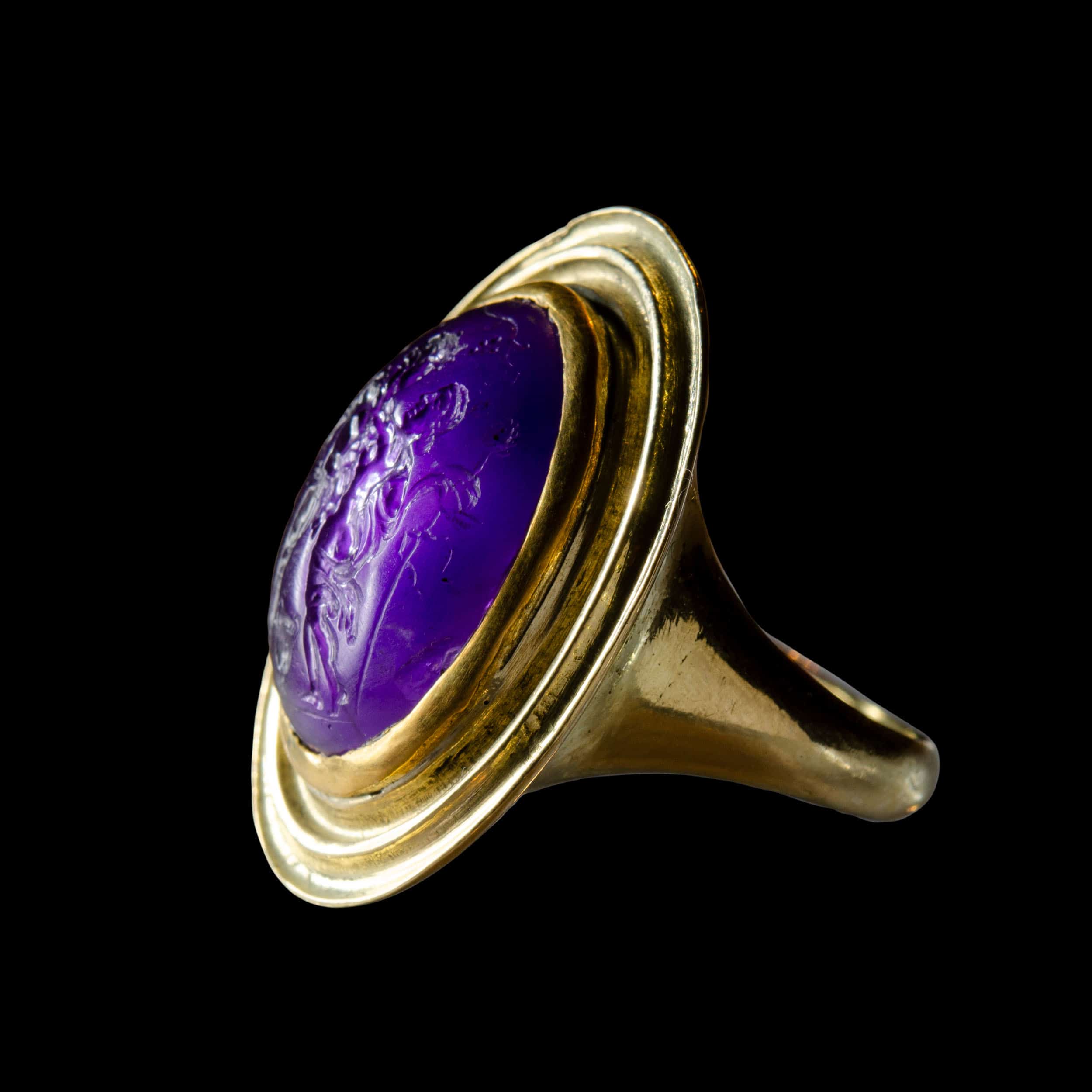Art hellénistique, IIème siècle av. J.-C.
Intaille en améthyste ; 11 x 20 mm
Monture moderne en or 18 cts ; 25 x 20 mm ; diam (int) 19 mm
TD_60 ; 16 grs
Provenance
Paris, collection privée
Cette scène fascinante se compose de deux personnages: un satyre et une ménade. Le personnage masculin est debout, tourné vers la droite, la jambe largement écartée, il tient une crosse de sa main droite. Son visage, de trois-quarts tourné vers la gauche, est surmonté de petites cornes et de baies dans ses cheveux. Son corps jeune et fort se caractérise par une musculature bien marquée. Devant lui, au premier plan, une
ménade dansante en train de l’embrasser dans un geste érotique intime, kidnappée par la bête charnelle. Le phallus du satyre est ici, bien en évidence, laissant deviner la suite des ébats.
La ménade quant à elle, se dénude laissant apparaître son dos et ses fesses découverts. Le drap qui se dégage dans l’air flottant ne couvre que les cuisses. À gauche du satyre, un plan de vigne avec des grappes de raisins, encadre la scène. À droite de la ménade, le thyrse abandonné. À leurs pieds, un cratère, contenant le vin, un met propice aux actes charnels incontrôlés. Le choix de l’améthyste, pierre particulière de la sphère dionysiaque, convient parfaitement à la scène, puissante allégorie de l’amour charnel. La pierre est en cabochon, et montre des signes d’usure.
Tous les détails sont polis et la représentation est gravée avec grande finesse. En fait, le sujet à deux figures et attributs dans cette pose spécifique présente des difficultés d’exécution considérables, augmentées par la surface très convexe. Le visage de trois-quarts du satyre et l’élégante tournure de la ménade révèlent la grande habileté du graveur. La scène, bien que très rare, est attestée sur une empreinte de la collection Cades T. (Impronte dell’Instituto, X, classe II, A n.183 et XII, classe II, A n.512). La pierre est montée dans un grand anneau massif dont les formes rappellent les modèles hellénistiques.
La pierre montre des signes d’usure et un léger éclat à l’arrière de la gemme.
Notes de référence
Beazley Archive database, reference number 10.II.A.183, from Cades plaster impressions, Libro 10, classe II, A no. 183 (“Kidnap of a bacchic follower by a satyr with a crook and a nebride. A vase is thrown onto the floor”); for the pose, see Cades, Libro 9, classe II, A, no. 60 (“Bacchus with thyrsus and cantharus supported by a satyr with his foot and accompanied by a panther”), and Cades Libro 12, classe II, A no. 512 (“Satyr stands with a crook and a woman sitting”).
AN IMPORTANT LATE HELLENISTIC AMETHYST INTAGLIO SET IN A MODERN GOLD RING. EROTIC DYONISIAC SCENE. 2ND CENTURY B.C.
03/8 x 04/5 in. Intaglio. This fascinating scene consists of two characters: a satyr and a maenad.
The male figure is standing, turned to the right, his leg wide apart, holding a stick in his right hand. His face, turned three-quarters to the left, is topped with small horns and berries in his hair. His young and strong body is characterized by a well-defined musculature. In front of him, in the foreground, a dancing maenad kissing him in an intimate erotic gesture, kidnapped by the carnal beast. The phallus of the satyr is here, clearly visible, suggesting the following step.
The maenad, reaveling her back and, the butt uncovered. The sheet that emerges in the floating air covers only the thighs. At the left of the satyr, a plan of a vineyard with bunches of grapes frames the scene. At the right of the maenad, the abandoned thyrsus. At their feet, a crater, containing wine, symbol of uncontrolled carnal acts.The choice of amethyst, a particular stone in the dionysiac sphere, is perfectly suited to the scene, a powerful allegory of wild love. The stone is in cabochon, and shows signs of wear. All the details are polished and the representation is engraved with great finesse. In fact, the subject with two figures
and attributes in this specific pose presents considerable difficulties of execution, augmented by the very convex surface. The three-quarter-length face of the satyr and the elegant turn of the maenad reveal the great skill of the engraver. The scene, although very rare, is attested in an imprint from the Cades T. collection (Impronte dell’Instituto, X, class II, A n.183 and XII, class II, A n.512). The stone is mounted in a large massive ring whose shapes recall Hellenistic models. The stone shows signs of wear and a slight sheen on the back of the gem.
Description complète















